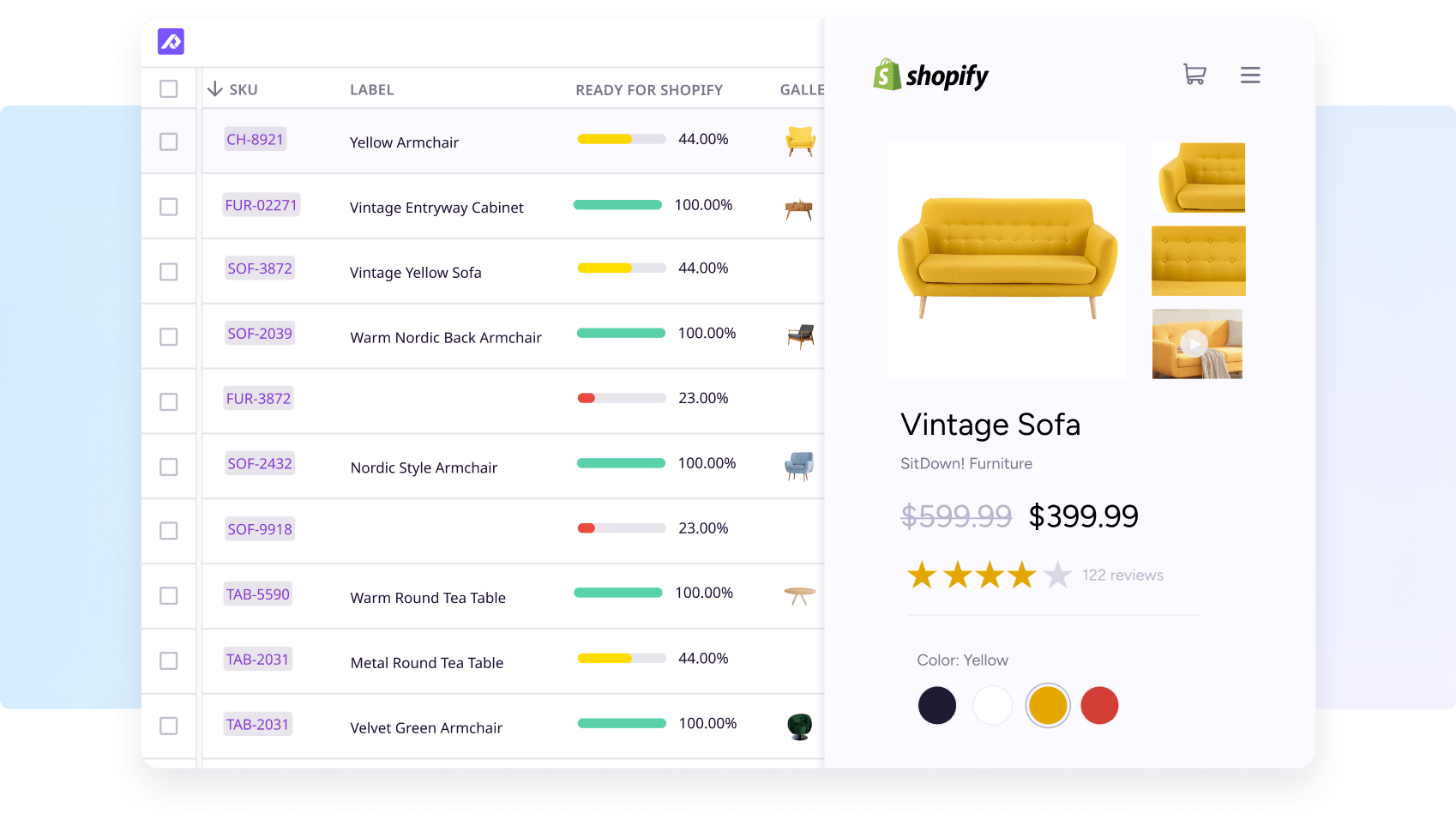PIM for Shopify
The best way to manage product content for your Shopify store



Ranked Best PIM software in G2's Best Commerce Awards 2025

Work as a team
Managing product data is a team effort. Easily collaborate with your team using specialized views and work together at the same time without stepping on each other's toes.
Be safe, not sorry
With Plytix your team can work on product content in a safe space outside Shopify.
This means no more accidental product content errors on your store.
More than 1,000 Shopify stores run on Plytix PIM
What can Plytix PIM do for you and your Shopify store

Keep your images organized and ready to go
All the versions you need, without duplicates
Link multiple images to products and variants
Preview everything before it goes live

Keep your Shopify store up to date with minimal effort
Update 1,000s of SKUs in one go
No more product errors or data gaps
Schedule automatic product updates

Automate mundane tasks
Easily find gaps in your product data
Apply rules to enrich data in bulk
Take back thousands of hours of your life

Step up your content game
Create content that helps your pages rank
Translate content instantly with AI
Skip the duplicated work across regions
The time I spend on product updates has fallen by at least a factor of 5.
And, others on my team can use Plytix to update what they need to. They used to send me an email, so I could do it, since it meant updating a spreadsheet and uploading that to Shopify. But now they can just do what they need to, and keep me out of the loop.

Robert Ferrell
Co-owner, Chama Valley Meats
Easily transfer your entire Shopify store to Plytix. It only takes a minute or two.
No need to start from scratch
Easily transfer your entire Shopify store to Plytix. It only takes a minute or two.



Top 4 reasons companies choose Plytix for their Shopify store
1. Combining two best-in-class ecommerce tools just makes sense
You’ve already made the choice to work with one of the top commerce platforms in the ecommerce landscape. Wouldn’t it be a good choice to go with the #1 PIM software too?
2. An easy interface that anyone can use
Let’s be honest: your Shopify store is not the best place to manage data.
Switch to a clean, organized, and easy-to-use interface and map your product data with pre-populated Shopify fields.
3. Insanely good support
Working with Plytix Customer Success feels like having your own in-house support team. Our team is here to help you succeed—not just with Plytix but also with your business goals.
Whether it’s expert guidance or helpful resources, we’ve got your back every step of the way.
4. No development needed
Made by product data people for product data people. With Plytix, you don’t need a development team. With our direct integration with Shopify, you can save the money you would have spent on setup and maintenance for something more beneficial for your business.
Find out if Plytix is right for you—on your terms
Talk to a solutions specialist
Want expert help? Book a 1:1 session.
A quick, free chat to talk about your needs.
Live chat
Have questions? We’ve got humans.
We’re online Monday–Friday, 10:00 am–8:00 pm (CET).
What best describes your company?
What are you solving for?
data & assets
product content
feeds
B2B catalogs
products
marketplaces
content with AI
images with AI
Passport rules
product data sheets
content faster
How did you hear about us?
Frequently Asked Questions
What is PIM used for?
A product information management system, or PIM for short, is used to store, manage, edit, and even create product information like descriptions, prices, digital assets, SKUs, and more. It's like an organized hub where businesses can keep all their product data in one place. With Plytix PIM you can manage, enrich, and share product catalogs easily. It helps teams work together smoothly, maintain top-notch data quality, and makes sure customers get the right information on whatever channel they’re shopping on.
Read more: What is PIM?
Do you need PIM for Shopify?
If you sell across various channels or regions—or manage a growing number of SKUs, absolutely! While Shopify is an excellent platform for running your online store, it’s not specifically designed to store, manage, optimize, or distribute your product data to multiple platforms. That's where a Product Information Management system (PIM) like Plytix comes in. A PIM like Plytix lets you centralize your catalog, automate updates, manage variants more effectively, and publish product content faster across all your channels.
Does Shopify have its own PIM system?
No, Shopify does not have its own PIM system. Shopify is designed for online store management. It’s able to host product data for a Shopify store itself, but it doesn't offer the specialized tools needed for advanced product information management across various channels. It lacks capabilities like structured product hierarchies, data validation, bulk editing at scale, multi-language support, or automated content distribution. A dedicated PIM like Plytix fills those gaps and serves as a central source of truth for managing and enriching your product data before it reaches Shopify and other channels.
Can PIM replace spreadsheets for managing product information?
Yes. Many brands come to Plytix when spreadsheet-based workflows start breaking down. Managing product information manually often leads to version conflicts, inconsistent data, and wasted time. A PIM system centralizes your product data in one place, giving your team a single source of truth that’s easier to manage, scale, and trust.
Does PIM support bulk editing?
Yes. Plytix makes it easy to update large volumes of product information at once. Whether you're editing descriptions, pricing, images, or custom attributes, you can apply changes across thousands of SKUs—without having to rely on CSV exports or manual updates inside Shopify.
How does PIM help with managing complex product data in Shopify?
As your catalog grows, Shopify’s limitations become more apparent. Plytix helps you manage complex variants, organize large volumes of product images, normalize inconsistent supplier data, and handle custom attributes more effectively. Everything stays structured, consistent, and easier to update—without relying on time-consuming workarounds.
Can PIM help with localization or managing stores in different regions?
Yes. If you operate separate Shopify stores for different regions or languages, Plytix PIM makes it easier to manage those workflows from a single platform. You can create and store localized product content, manage regional variations, and publish the right information to the right store without duplicating everything manually. It’s super helpful if you’re running in different markets and need to tweak things like pricing, language, or product details for each one.
How much does PIM for Shopify cost?
We keep pricing simple and affordable (no surprises). With Plytix, you only pay for what you need. Plans start at €699 per month.
Compare Plytix pricing plans.